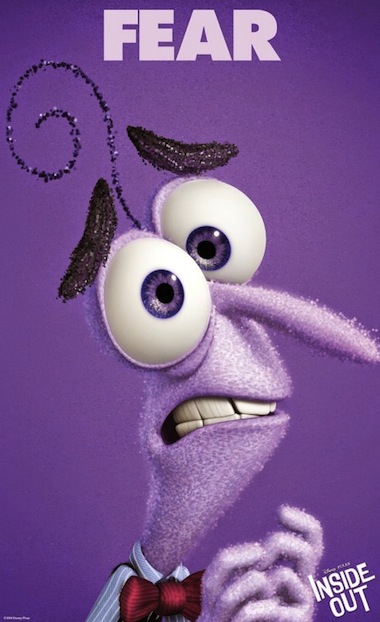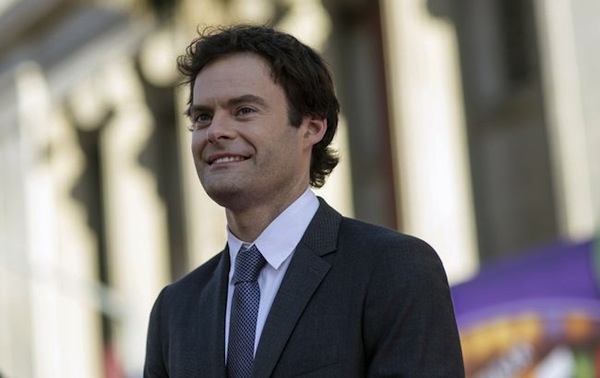
By Jeremy Smith
For nearly a decade, Bill Hader was one of SATURDAY NIGHT LIVE’s most versatile and reliably hilarious cast members. Throughout his tenure, he created a number of recurring characters that, shockingly, failed to wear out their welcome. Your mileage may vary, of course, but I was always thrilled to see scenester Stefon, belligerent reporter Herb Welch, The Californians’ Devon, inept Italian talk-show host Vinnie Vedecci or the dude who’s got TOTAL RECALL’s Kuato housed in his abdomen. Hader was also one of the most gifted impressionists in the show’s history: Al Pacino prowling the stage in “You’re a Rat Bastard, Charlie Brown”, Vincent Price contending with whacked-out celebrity guests on various holiday specials, Alan Alda circa 1984 randomly auditioning for the role of Biff in BACK TO THE FUTURE… these are just a few personal favorites. There are dozens more that are just as brilliant.
Hader’s career outside of SNL has been just as eclectic and wonderful in its own right. Whether co-starring alongside Kristen Wiig in the terrific sibling dramedy THE SKELETON TWINS, winning an Emmy as one of the producers of SOUTH PARK’s thirteenth season, or hosting TCM Essentials Jr. (thereby revealing his impeccable taste for vintage cinema), Hader seems to be having a blast doing whatever tickles his fancy. Later this year, we’ll see him attempt to romance Amy Schumer in Judd Apatow’s TRAINWRECK, and goof on classic documentaries with his new IFC series, DOCUMENTARY NOW! (which he co-created with Fred Armisen and Seth Meyers).
But right now, we get to enjoy Hader’s vocal wizardry in Peter Docter’s INSIDE OUT, the latest masterpiece from the director of MONSTERS, INC. and UP. Set in the mind of a young girl named Riley, Hader frets and panics as the emotion Fear; working alongside Joy (Amy Poehler), Sadness (Phyllis Smith), Anger (Lewis Black) and Disgust (Mindy Kaling), it’s Fear’s job to protect Riley from danger. Hader blends in beautifully with this talented ensemble, and the result is a film that will work your tear ducts like George Foreman pounding the heavy bag in WHEN WE WERE KINGS. Good luck rope-a-doping this emotional juggernaut.
When I chatted with Hader at last week’s press junket, I had three objectives: 1) talk INSIDE OUT, 2) geek out over cinema (particularly Lubitsch’s TO BE OR NOT TO BE), and 3) ask him what it was like to act with LeBron James in TRAINWRECK (since I doubt I’ll double up on Hader when that press day rolls around). I got 1 ¾ out of three covered. As always, Hader was a great interview, and just a swell guy.

Jeremy Smith: It’s great to talk to you, man!
Bill Hader: Thanks!
Jeremy: I’ll try not to get all cinephile with you.
Hader: (Laughs) The only thing I’ve seen lately is MAD MAX. I saw it four times. I saw it with my wife, and when it started, she went, “Oh, this isn’t my kind of movie.” Then it ended, and she went, “I want to see that again. Like now.” So we got back in line, and watched the movie again. I’m so late to stuff, but I really liked STARRED UP. I also thought BLUE RUIN was great.
Jeremy: BLUE RUIN was excellent. That was one of my top movies of last year.
Hader: It’s so good.
Jeremy: Well, there’s lots of good stuff coming up, like INSIDE OUT. One of the great things with Pixar is that they can get any actor they want, but they’re so meticulous about matching the right voice to the right character. How do you feel that they determined you were the absolutely perfect voice for Fear?
Hader: Like you said, I’m a big movie geek, so I actually went to Pixar. It was the other way around. I was like, “Can I go there and meet them and take a tour?” I met Pete and Jonas [Rivera, the producer of INSIDE OUT], and we became friends. They came to SNL and did a research trip for the dream production sequence. And they said, “Hey, let’s return the favor. You want to come and hang in the story room?” I didn’t know what the story [of INSIDE OUT] was, but I went, and that’s when they first told me the story. It was much different than it is now. There was a little girl and all the emotions in her head, but there was nothing about her moving [to San Francisco] and hockey and all of that. The story wasn’t there, but the elements were kind of there. Then at the end of that week, they said, “Do you want to record something so we can hear all of the voices?” So there’s an audio someplace of me doing all of the emotions, and I wasn’t that great. But the Fear thing I did they liked, so they said, “Do you want to play Fear?” It seems like this very circuitous way of me getting into a Pixar movie, but, to be honest, writing is something I’m not that naturally good [at doing]. It’s something I wanted to learn a lot about, so that’s why I wanted to hang with them. And also hang out over at SOUTH PARK, and see how it’s done. So a learning experience turned into a job – and a dream come true, because I’m a huge Pixar fan.
Jeremy: Listening to you as Fear, and knowing you’re a big movie buff, I found myself trying to tease out some of the potential influences. Like, “Is that a little Don Knotts in there…?”
Hader: It’s funny, because Don Knotts is the guy they brought up, because he’s always scared. I sent Pete a bunch of different voice ideas, and he said, “Maybe do it closer to yourself. Maybe playing this middle-management bureaucrat guy would be good.” So that’s what we went with. But when you play scared and high-pitched like this, Don Knotts is a good direction.
Jeremy: In terms of the development of the narrative, Pixar has a reputation for breaking the story as they go along. At one point, we kept hearing FINDING NEMO was going to be a disaster, and then it winds up being one of their very best. Getting to sit in on that process as an outsider, what’s it like?
Hader: It’s different for every movie, but I know for this one, and the way that Pete works, is that Pete is very intuitive. He says, “That feels right,” or “That doesn’t feel right.” It’s got to feel somewhat personal for him. When you’re kind of doodling something, and you sit back and look at it, and go, “Look at this. Is this thing a reflection of my subconscious? What is this?” – that’s the kind of level Pete’s at all the time. It’s visually very exciting for him all of the time, but also emotional and honest. Pete also loves talking about story. You talk about act breaks and stuff like that, but Pete’s not one to get hung up on, say, “The subtext is this,” or “You have to have an Act Two reversal.” It’s just what feels right. You think about a classic film like THE GOLD RUSH, I don’t think Charlie Chaplin was saying, “What’s the Act Two reversal?” It’s just that stuff needs to happen. They tend to operate on that thing that Trey Parker talks about, which is if you look at your outline for your story, and it says “This happens, and this happens, and this happens…” that’s wrong. It needs to be, “This happens, so therefore this happens, so therefore this happens, but then this happens, so now therefore this happens.” It’s a domino thing.
Pete likes that, but it doesn’t happen linearly. You get excited about certain aspects, and then you try to fit them together. Then it’s like, “These aren’t really fitting together, so we’ve got to change that to this, and then morph these two things, and… eh, I still don’t like it. Well, let’s get rid of that whole thing!” If you saw it at year three, you’d go, “That’s the movie that became INSIDE OUT?” It’s just not there yet. But they are very comfortable and confident in their process. They know they’ll get there eventually. I’m learning it’s always about logic and emotion. “What’s the emotion that’s happening right now?” It could be the most insane, funniest, silliest, fantastical thing in the world, but if it doesn’t have some sort of logic to it, I can’t wrap my head around it. I think David Lynch movies have a lot of logic to them. ERASERHEAD totally makes sense to me. On an intuitive level, it hits something that’s emotional.
Jeremy: It’s dream logic, and it makes dream sense.
Hader: Totally dreamy and weird. “What does the woman in the radiator mean?” That movie’s about the fear of having a kid, and all these things.
Jeremy: Speaking of making sense of odd and chaotic things. I know you went to see Joe Dante’s THE MOVIE ORGY a few years ago at The New Beverly. I went to a later screening, but it’s amazing because you think it’s just this collage of campy movies, but then you realize there are callbacks.
Hader: There is a story going on in a weird way using actual films. I went with Edgar Wright and Quentin Tarantino, and it was like, “The only way we’re ever going to see this is if we go the the New Beverly.” They can’t release it because it’s all copyrighted material. It’s like four hours long.
Jeremy: The version I saw was even longer. He keeps adding stuff to it.
Hader: You’re like, “What is happening?” It’s this montage of these kinds of ‘50s B movies: biker movies and monster movies and all of these things. But then you realize there’s a structure to it, and that this one character, through editing, he makes it seem like he has a relationship with this person from this other movie. It was really amazing.
Jeremy: It’s connecting the “Don’t crowd me” line that does it.
Hader: Yeah, “Don’t crowd me” got the biggest reaction. The place went bonkers when that happened. This is what happens when you start working on these things. I used to be in my room as a film fan, and you start working in it, and then you start going to meetings with executives, and you see how people think in those terms. They get a lot of flack, but a lot of times their notes are so smart. Scott Rudin’s got one of the best story minds of anyone I’ve ever met. Matt and Trey love him because he’s got a great story mind. He’s like, “Cut that out, so you get to that at this point.” They’re thinking about the audience. But when you make things for yourself, like if you go see a Paul Thomas Anderson movie or a Lars von Trier film, those are filmmakers making movies for [themselves]. And I want to see that, too. Fred Armisen, Seth Meyers and I just made this show called DOCUMENTARY NOW, which parodies different documentaries. We did some long-lead press for it, and someone asked, “Who is this show for?” And we’re like, “It’s for us! We’re nerds!” And they said, “Do you think anyone’s going to get that this is a big parody of THE THIN BLUE LINE?”
Jeremy: So you’re doing Errol Morris. Are you doing the Maysles?
Hader: Yeah. We’re doing ones that I think are pretty well known. GREY GARDENS, NANOOK OF THE NORTH, THE THIN BLUE LINE…
Jeremy: You should do HARLAN COUNTY USA.
Hader: Yeah, but I actually haven’t seen that yet.
(I get the last question signal.)
Jeremy: So Alan Alda recently joined Twitter.
Hader: He did?
Jeremy: He did! I was delighted to see that because it felt so unlikely. But when I read the tweets, they’re so Alda that I can’t help but hear your impression of him. It’s one of the most oddly perfect impersonations I’ve ever heard.
Hader: Well, Peter Serafinowicz also does a great Alan Alda impression. I think his is better than mine. But I got it from watching CRIMES AND MISDEMEANORS with my wife. He was doing the whole “If it bends it’s funny, and if it breaks it’s not funny.” So I started repeating that the next day. I don’t feel like I got all of my impressions right, but the ones I got right, they start off as one thing and then I hit some level where… it’s scary. You’ll hit it right, and then you can’t get it back. But with that, I kept doing it all week, and I just got lucky that they were doing the BACK TO THE FUTURE auditions sketch. I was like, “Can I do Alan Alda? Because I’ve got it. This week, I’ve got it.” That happened when I did Daniel Plainview. I just had it, and I was like, “Please don’t go away! Can we please do a THERE WILL BE BLOOD sketch this week!” But I’m glad you liked it.
Jeremy: Loved it. You should do an Alda-off with Serafinowicz.
Hader: (Laughs) Oh, he would win.
You will win when you check out INSIDE OUT this Friday, June 19th!
